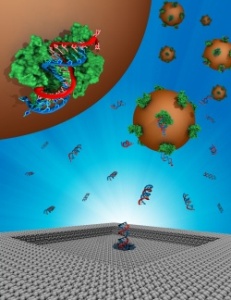Oct 26 2010
Researchers at the University of Pennsylvania have developed a new electronic method for detecting microRNA isolated from living cells.
MicroRNAs are a class of small biomolecules that control gene expression into proteins, the “workers” of the cell. MicroRNAs act by binding to specific messenger RNAs that code for proteins, and, by doing so, inhibit protein synthesis.
 Probe-microRNA duplexes translocate through thin nanopores
Probe-microRNA duplexes translocate through thin nanopores
MicroRNAs, or miRNAs, were initially identified in roundworms in 1993. Since then, biologists have discovered that microRNAs control gene expression, and therefore there is immense interest in these molecules as potential therapeutics for silencing cancer and disease-related genes.
The problem with microRNA detection is that the number of copies of microRNA in cells is so small that detection is quite challenging. The team developed a method to fabricate nanopores in the thinnest silicon nitride membranes reported to date, about 6 nm thick.
First, the team showed that these nanopores increase the signal resolution from reading DNA molecules as they pass through the pores. After demonstrating the enhanced sensitivity, the Penn team needed a method to isolate a specific microRNA from cells.
They teamed with a group headed by Larry McReynolds of New England Biolabs.
“Larry and co-workers had a neat trick: they use a viral protein called p19 to tightly bind duplex RNA molecules of the exact dimensions of microRNAs,” Meni Wanunu, a research associate at Penn, said. “So we devised a plan that uses this protein to isolate very small amounts of specific microRNAs that we can then quantify using our pores.”
The team focused on detecting miR122a, a liver-specific microRNA in mammals.
They first demonstrated that their nanopores are reliable enough to quantify the concentrations of these tiny molecules that are only 22 bases long, or 6 nm in length. After having made ultrathin membranes by locally etching silicon nitride, the group used electron beams to drill the nanopores in the thinned portion of the silicon nitride membranes.
“Using 3 nm diameter pores, these duplex RNA molecules just squeeze through the pores and in doing so, each molecule produces a nice electronic signal,” Wanunu said. “We were delighted, things worked out really nice. These are the smallest synthetic pores in all dimensions, and it is surprising how stable and robust they are. We now use them routinely for various investigations; they are our new state-of-the-art.”
The article, featured on the cover of the November 2010 issue of Nature Nanotechnology, shows a duplex microRNA molecule passing through a very thin nanopore made at Penn.
“It is wonderful to see the expected improvements in signal to noise ratios using these thin nanopores,” Marija Drndiæ, an associate professor of physics and the group leader on the project, said. “In spite of their being thin, they are quite robust, and they seem to function every time because they do not tend to trap hydrophobic contaminants and they allow unimpeded flow through them. All this makes them ideal candidates for various biophysical applications.”
The Penn team is now working on specific methods for detecting other small molecules, as well as integrating these nanopores with fluidic systems to improve sensitivity.
The research was conducted by Wanunu, Drndiæ Tali Dadosh and Vishva Ray of Penn, and Jingmin Jin and McReynolds of New England Biolabs.
The research was supported by a National Institutes of Health grant and the Penn Genome Frontiers Institute of the Commonwealth of Pennsylvania and Pennsylvania Department of Health.
The Department of Health specifically disclaims responsibility for any analyses, interpretations or conclusions.
Source: http://www.upenn.edu/